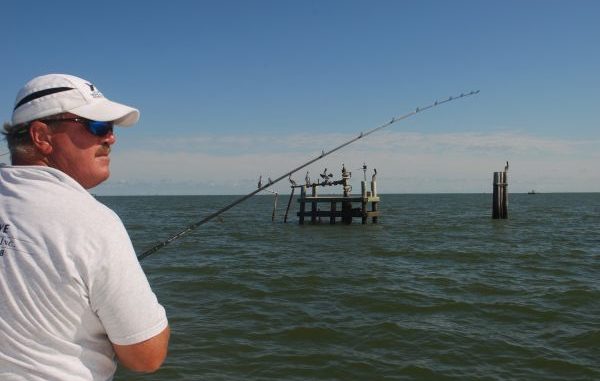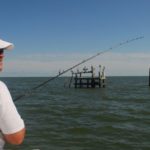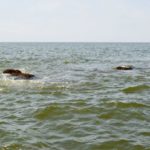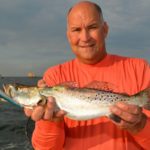
This huge estuary extends from the Bayou Lafourche ridge on its eastern side to the lower Atchafalaya River on its western border. Vast tracts of freshwater marsh and swamp lie within its northern boundaries.
The marshes become progressively more saline toward the south. The system’s lower boundaries were once clearly defined by stretches of barrier islands that protected the system’s interior marshes from high-energy Gulf of Mexico weather events.
These islands are so eroded now that it is sometimes said that the Gulf has moved into the bays.Between John “Hawkeye” Aucoin of Hawkeye Fishing Charters (985-632-6988) and Tracy “T.L.” Bayles of Choctaw Fishing Charters (225-284-5256) there exists 41 years of guiding experience and over 70 years of total fishing experience in the Timbalier-Terrebonne estuary.
And in assessing last year, both men agree on one thing: Fish in their area averaged larger than usual. But the news wasn’t all positive.
“Last year,” Aucoin said, “was a good year size-wise, but the numbers weren’t there early — April and May, although they picked up some in June, July and August. We didn’t have the influx of small fish like we usually get.
“It’s like there was a size class missing. The average size of fish we caught was bigger. As we would put it, ‘They were a good grade of fish’ — a lot of 2-, 3- and 4-pound trout.”
Another difference that Aucoin pointed out was that speckled trout didn’t turn up on the beaches of East Timbalier Island (or what’s left of it) in April like usual. Instead, fishing was better farther to the west: the Monkey, Last Island and the New Cut.
Not until well into May and June did specks turn up in numbers off East Timbalier.
“Last year,” he summed up, “wasn’t a limit deal. Normally a skilled fisherman can catch limits here. Not last summer.
“But you still had the same amount of meat because the fish were bigger.”
Fall was typical for the estuary, with excellent catches until the weather turned bone-chilling cold.Bayles’ 2013 experience was similar, with fewer trout coming off the beaches early. Some of that he attributed to the late cold fronts of the previous winter and windy conditions in March, April and May.
Like Aucoin, Bayles noted an increased number of larger fish in his catches. Trout catches often averaged 2 pounds, which is very good for this estuary.
By summer, catches of good trout were still being made, but they were mixed in with large numbers of schoolies, trout a little under or over 12 inches long.
By August and September, he was seeing “beau coup” small fish.
“There was a real healthy batch of young fish everywhere,” Bayles said.
His fall was like Aucoin’s: very good, with limits of trout being caught. Most of these fish were 1 to 1 ½ pounds.
The cold winter we’re coming out of worries Bayles.
“Water temperature keeps dropping into the high 30s,” he said in February. “I’m sure that it’s got to be stressing. Getting close to death time and time again has to affect them.
“I am a little worried how this will affect the spawn. Also, if the fish aren’t able to feed, their growth rate has to slow down.
Trout catches in January and February, both men agreed, have gone to zero. Bayles suspects that speckled trout are overwintering farther south than normal in high-salinity, warmer water.
Aucoin also factored in the effects of coastal erosion. Islands are gone, reefs are gone and deep channels have filled in. Cold front after cold front has kept interior waters dirty with suspended sediments.
Bayles said he hoped the lack of fishing pressure during the winter coupled with all the trout they saw in the summer and fall will produce good fishing this year.
“I think that when we get south winds, they will push bait back inside, as well as increase salinity and water temperature,” he said.
Aucoin, who didn’t see as many small speckled trout as Bayles did, still thinks that “in general” the season will be good.
“If it is early or late depends on the weather,” Aucoin said. “We had nice fish last year, and I hope there is some good hold-over from that.”
The lack of 10- to 11-inch fish — “dinks,” as he calls them — is a concern, but Aucoin noted that it is getting harder and harder to predict trout seasons in recent years.
“For example,” he said, “who could have predicted last year’s numbers of bigger fish. Each year is different; Mother Nature has a way of taking care of its own.”
Aucoin’s April recommendation is to stick to transition spots — places where fish travel, such as main channels with heavier currents.
Preferred baits are soft plastics on jigheads, most often fished under corks but also tight-lined.
By May, fishermen should shift to open waters like Lake Raccourci, Old Lady Lake, Lake Barre and Lake Felicity. They should concentrate on what islands are left, and on oil and gas structures.
Soft plastics still rule the first part of the month, but later shrimp turn up and shrimp under corks is effective, as are croakers on Carolina rigs late in the month.
June is basically a continuation of May, with more emphasis on fishing beaches. Live bait is very effective, although Aucoin sticks with soft plastic when he can.
In July the water has become hotter, and less fishing is done near islands and the action moves to near structures in deeper water.
Bayles’ recommendations reflect his love of fishing East Timbalier Island, which he suggested trying as soon as the weather allows travel there in April. He also recommended hitting oil and gas rigs in the lower bays and islands, reefs, and even eroded and submerged reefs that can still be located on old GPS units.
April spots include Northwest Island, the west end of Casse-tete Island, Philo Brice Islands and Brush Island.
His recommended baits are soft-plastic swimbaits, jigs and his pet lure, a silver Bomber Long A with a blue back.
Much of the same pattern continues into May, with the addition of live shrimp under corks and free-lined croakers being added. West Timbalier Island and the barges on Fourchon beach are added destinations.
In June, fishing shifts away from beaches toward rigs that sit in 7 to 9 feet of water in the bays, although deep spots at East Timbalier are also good. Live shrimp under corks, free-lined croakers, swimbaits, jigs and Bombers are all still effective.





